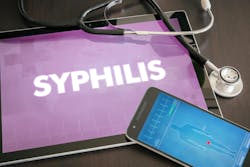Study Shows Optional Syphilis Tests in Emergency Departments Lead to Increase in Screening and Diagnosis
Providing optional syphilis tests to “most people seeking care at a large emergency department led to a dramatic increase in syphilis screening and diagnosis, according to a National Institutes of Health (NIH)-supported study of nearly 300,000 emergency department encounters in Chicago.” Crucially, most people diagnosed had no symptoms. NIH's website has the release.
CDC estimates that “adult and congenital syphilis cases increased by 80% and 183% respectively between 2018 and 2022.” Despite this, the “optimal model for syphilis screening has not been identified.”
In this study, optional syphilis tests were offered to anyone “whose electronic health record indicated they were between the ages of 18 and 64 years, had no documented HIV diagnosis, and had not been screened for HIV within the past 12 months. Syphilis testing also could be ordered for anyone not meeting those criteria based on clinical decision making.” The study assessed 299,651 emergency department encounters between June 2017 and May 2021 – “two years before the novel screening strategy intervention was introduced, and two years while it was in use.”
Post-intervention, testing increased from 3.6% of people to 24.4% of people. The number of people with presumed active syphilis also increased from 161 to 624. Additionally, “confirmed syphilis diagnoses among pregnant people increased from two cases pre-intervention to 15 post-intervention, while the positivity rate remained constant, suggesting many missed opportunities for diagnosis pre-intervention.”
The authors suggest that “optional emergency department screening could help close current healthcare gaps in syphilis diagnosis and treatment, including among pregnant people, high incidence populations, and people with limited access to routine health care.”

